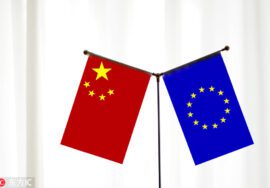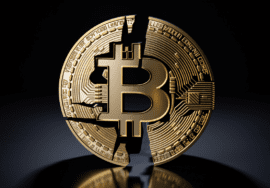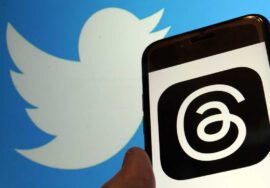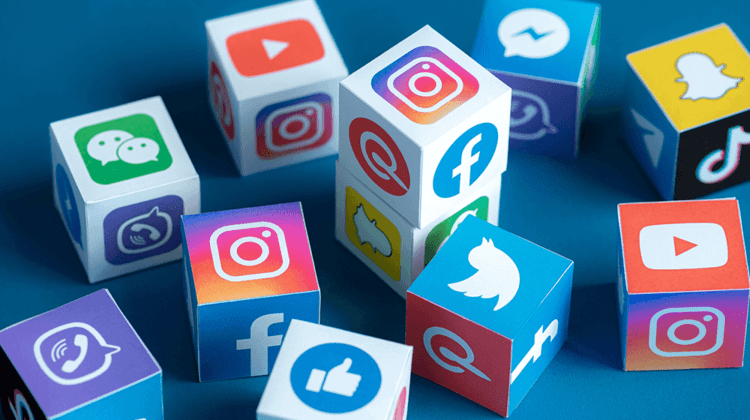

Modern consumerism and the role of social media


Op/Ed by Arsim.Ajeti
arsim@thejournalbiz.com
Days ago, the ‘Orwellian’ inspired show that entertains millions of youngsters around the world, started its live broadcast on the local TV in Kosovo.
The plot is obvious, few individuals are completely ‘isolated’ from the outside world, while their reaction are monitored by the public ‘eye’. Participants over time gain followers through the daily viewers, some fail to impress the audience, but in the end only one emerges as the winner.
Tweet on time spent interacting on social media
Globally, how much time did we spend interacting on social media?
Apparently, @Statista has an answer!#trends #Online #social #Apps pic.twitter.com/C2DCjhofJG— The_Journalbiz (@the_journalbiz) December 23, 2022
STATISTA Chart on global social media usage
More or less, this is the whole story, otherwise known as ‘Big Brother’. Initiated by the Dutch production ‘Endemol’, back in 98/99, ‘Big Brother’ has managed to attract different age groups, but the most prominent one remains the Gen Z (or the youngsters aged from 17 to 27 years old). Gen Z are considered the most ‘digitized’ generation with highest percentage of social networks, Insider data shows
Undoubtedly, ‘Big Brother’ still generates staggering financial gains, starting from click per view, (known as ‘click bait’) all the way to online marketing, which mainly generates from visibility of the product. So, perhaps it’s the very buzz from the audience, the society’s ‘hearsay” that makes this show profitable and still trending.
However, debunking the ‘Big Brother’ phenomenon isn’t something we can brag of about, but rather the influence on the consumers behavior intertwined with the academic point of view, that serves us to elaborate the very role of social networks in ‘ trend settings’ environment, and the impact it has on the viewers, or the consumer as the end product.
Miller (2006) argues that “exposure to social trends in one way or another makes us all a potential ‘targets’ of ‘online marketing’ otherwise known as ‘influencer marketing’. And as a consequence, we end up buying things we don’t need, with money we don’t have, trying to fit in with the ‘trends’ we don’t like, and all of this is accomplished through internet promotion though social media network.
Deloitte reveals that social media trends directly influence consumer change in over 70% of cases, and this is considered a high reach from marketing perspective. The interrelation of trends and consumers behavior starts from daily online habits through a certain individual or group aiming to promote a product or idea that in a short term becomes a social trend
Consequently, this tendency is followed in other sphere of our life, for instance in politics that promotes a certain ideology.
Tweet on Gez Z and the time spent on social media
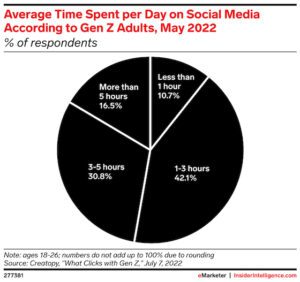

*Insider Chart on Gen Z social media trends
Otherwise, the topic as a whole is lectured on ‘Business and Marketing’ literature under the ‘viral marketing’. There are 3 basic sub-categories of viral marketing, that are conveyed by social networks to individuals and they are;
- Relevance: The influencer shares content about the specific business or industry.
- Reach: The number of people that can be reached and influenced through the social follower base.
- Promotion: Semantics, or visual level that influencer can create/influence the audience, on the given promotion.
As an illustration, Forbes magazine has selected highest paid influencers for 2022, and I’d pinpoint three names:
–Cristiano Ronaldo with 500 million followers on Instagram, paid approximately $1.7 million for one post
–Lionel Messi with 400 million followers on Instagram, paid approx.$1.5 million for a post
–Kim Kardashian and her sister Kylie with 340 and 350 million followers respectively, are paid about juts over $1 million per post
Contrary to being profitable, we also have the opposite side of the story, and this usually happens when the ‘power of social networks fires back’ when misused for selective or private issues. It is worth noting the artist, one of the top influencers in this field, Kayne West, known by the nickname YE.
Ye, within a short period of time, has managed to lose over $2 billion, from the anti-Semitic approach and derogatory approach on his official ‘Twitter’ and ‘Instagram’ account, and this has consequently led to the loss of almost all contractual income from top brands, the likes of: Adidas, Gap, Balenciaga.
In addition, even the former U.S president, Donald Trump, whose Twitter account was blocked after several ‘tweets’ during the infamous riots on Capitol Hill, has prompted the ban. Moreover, the loss of the presidential elections through chaotic scenes and the correlation of his tweets towards the event, caused him a record loss in the influence he had from the posts or ‘tweets’ (from his Twitter account)
Whereas in the local scene, the use of social networks is somewhat applied on an ad-hoc basis, and this usually is a reactive approach to social events, and not an elaboration of ongoing events or any discussion related to current social trends.
Perhaps a case where we have a correlation between the social campaign and personal projects, on awareness and the importance of mental health, was that of the artist Dafina Zeqiri. Last year though her hit-single “Duro”, in which she talks about her own difficulties and the mental problems in general, that prompted the song to go viral and thousands of #duro hashtags were spotted on Instagram feeds.
Tweet on TikTok top content during 2022
The most sought app of the year @tiktok_us
TikTok the journalbiz chart on top content categories during 2022#TikTokviral #viral #marketing pic.twitter.com/3hAYI7Ltf8— The_Journalbiz (@the_journalbiz) December 23, 2022
The Journalbiz chart on TikTok trends
However, the case of TikTok star Khaby Lame, who rose to fame posting funny short clips speaks volumes on the role, importance and power above all else that social networks nowadays represents.
That said the algorithm in TikTok is somewhat more immersive than the other social apps have, and that alone was enough for a 21 year old emigrant from Senegal, who now is considered a millionaire, and who is contracted as a brand ambassador of Boss, H&M. According to Forbes, Khaby Lame earns over 10$ Million per year from his TikTok account.
Impressive indeed, and as Adidas adverts reminds us all that, Impossible is nothing from today’s social media perspective, and that alone should not only make us curious, but also vary from the power that social media can generate, by engaging the masses and the viral sharing content on a global scale.

